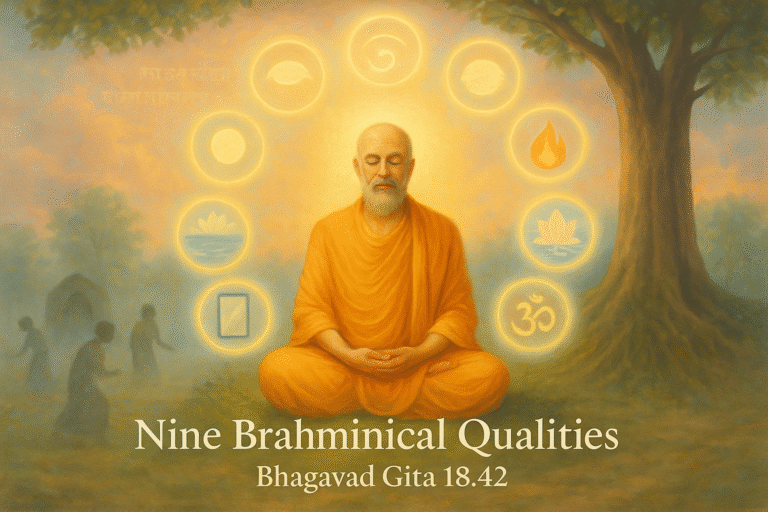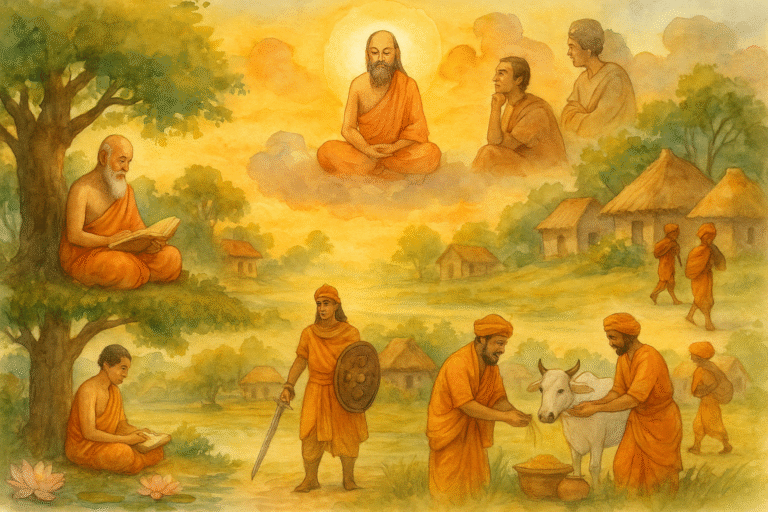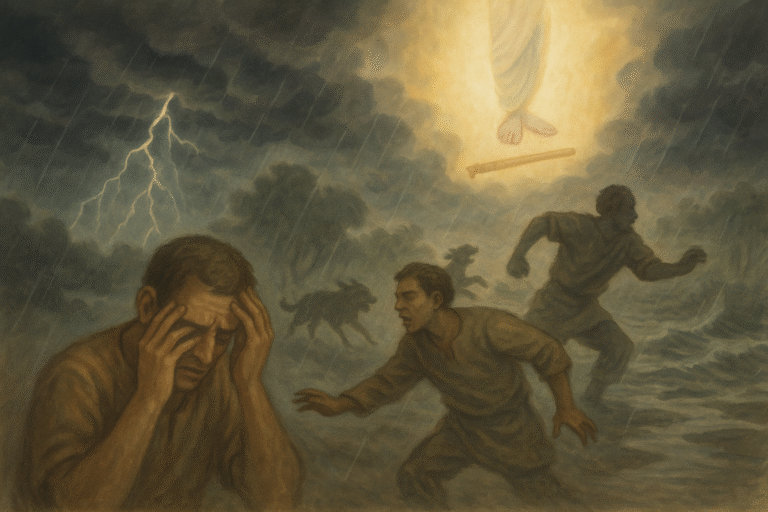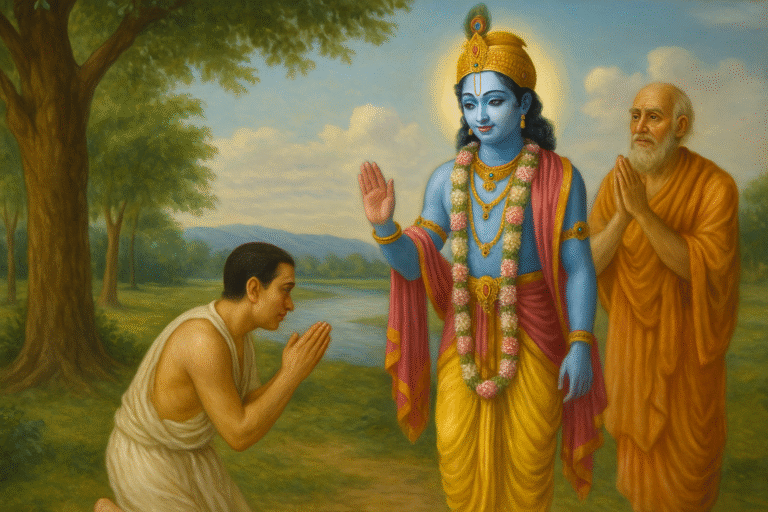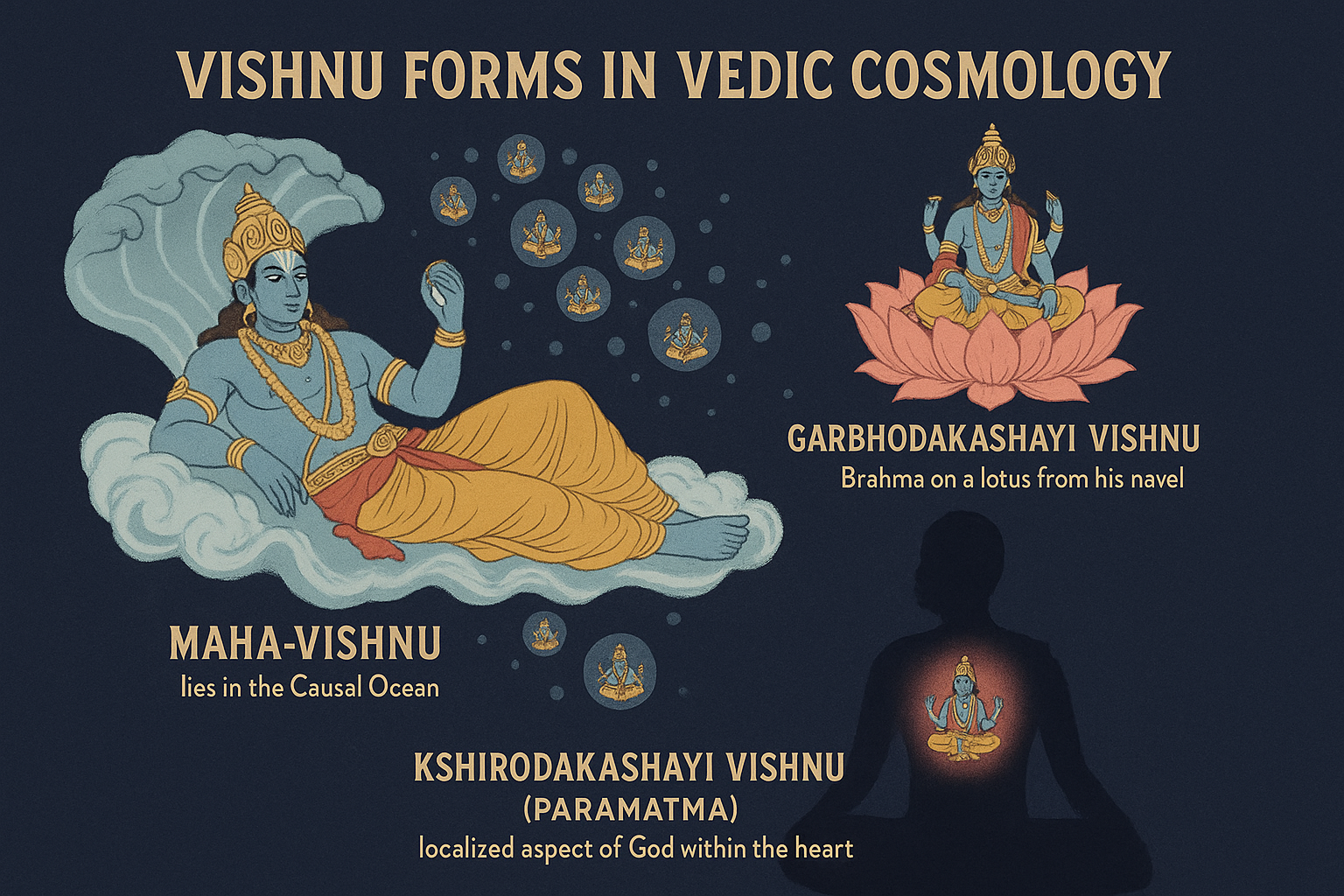Sri Chaitanya Mahaprabhu’s Journey to Jagannath Puri and the Deliverance of Sarvabhauma Bhattacharya
Sri Chaitanya Mahaprabhu’s journey to Jagannath Puri reveals divine pastimes — Lord Nityananda breaking His danda, the Lord enlightening Sarvabhauma Bhattacharya on the true meaning of Vedanta, and revealing why Lord Shiva preached Māyāvāda as Shankaracharya — ending in the Bhattacharya’s transformation into a pure devotee of Krishna.
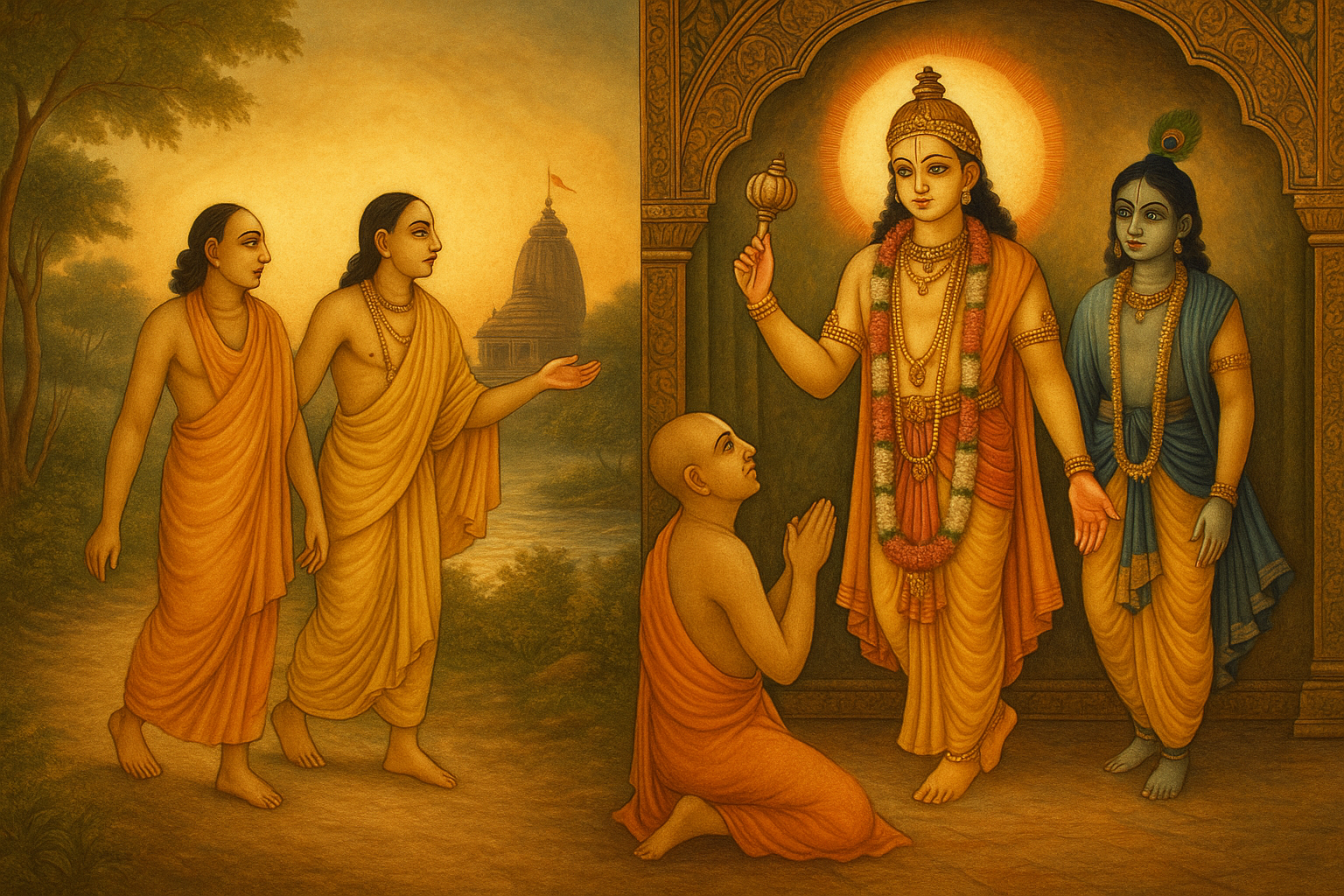
The Lord’s Departure Toward Nilachala
After accepting sannyāsa from Keshava Bharati at Katwa, Sri Chaitanya Mahaprabhu, the Supreme Lord in the mood of His own devotee, set forth toward Nilachala-dhama — Jagannath Puri — to take darshan of Lord Jagannath.
Accompanied by Lord Nityananda Prabhu, Mukunda Datta, and Jagadananda Pandita, the Lord journeyed while chanting the Hare Krishna Mahā-mantra in ecstatic love of God.
Every village He passed was filled with kīrtana and tears of joy.
The Breaking of the Danda
Sri Chaitanya Mahaprabhu carried a sannyāsa-danda, the emblem of renunciation. But Lord Nityananda, who is none other than Lord Balarāma, thought within Himself:
“My Lord is the Supreme Personality of Godhead, the master of all renunciates. Why should He carry a danda like an ordinary sannyāsī?”
When the Lord went to bathe in the river, Nityananda Prabhu took the danda, broke it into three pieces, and cast it into the water of the Bhargavi River.
When Mahaprabhu returned and saw it broken, He appeared externally angry and said,
“You have broken My danda — My only possession! I cannot stay with You any longer.”
Saying this, the Lord went ahead alone, walking swiftly toward Jagannath Puri, absorbed in the mood of separation from Krishna.
This pastime signifies that the Lord, being the original source of all sannyāsīs, is beyond the formalities of any āśrama. The danda-breaking leela is symbolic — He came to establish bhakti, not dry renunciation.
The Lord’s Arrival at Jagannath Puri
When the Lord reached Jagannath Puri, He entered the temple and beheld Lord Jagannath.
Upon seeing the Lord of the Universe, Chaitanya Mahaprabhu was overwhelmed with divine love. Tears flowed from His eyes, His limbs trembled, and calling out, “Jagannātha! Jagannātha!,” He fell unconscious.
The temple guards were astonished, but Sarvabhauma Bhattacharya, the chief priest and great Vedantist, recognized divine symptoms in the young sannyāsī and took Him to his residence for care.
The Bhattacharya’s Impersonal Teaching
Sarvabhauma Bhattacharya was a great scholar of Vedanta and follower of Advaita-vāda (impersonalism).
Out of affection, he thought:
“This young sannyāsī is very emotional and soft-hearted. He should learn the Vedanta philosophy properly to remain steady.”
For seven days, he instructed Lord Chaitanya in the Vedānta-sūtras, interpreting them according to Shankaracharya’s impersonal commentary.
Throughout those sessions, Mahaprabhu listened silently, showing neither approval nor objection.
The Lord Speaks the True Meaning of Vedanta
After seven days, the Bhattacharya asked,
“You have been hearing silently. Have You understood the Vedanta-sūtra?”
Sri Chaitanya Mahaprabhu smiled and replied,
“The sutras themselves are luminous, but your explanations are like clouds covering the sun. The real purport of Vedanta is to glorify the Supreme Person, not to deny His form.”
The Lord then quoted many verses from Śrīmad Bhāgavatam, Bhagavad-gītā, and other scriptures, establishing that the Absolute Truth is the Supreme Personality of Godhead — full of eternal form, knowledge, and bliss (sac-cid-ānanda-vigrahaḥ).
He declared:
“The purpose of the Vedas, Vedanta, and all scriptures is to awaken pure devotional service unto Krishna. The impersonal conception is a temporary device to mislead those who are envious of the Lord.”
The Revelation About Shankaracharya and Lord Shiva
Still not fully convinced, Sarvabhauma Bhattacharya inquired about Shankaracharya’s authority.
Lord Chaitanya then revealed a confidential truth:
“Shankaracharya is none other than Lord Shiva himself, the greatest devotee of the Lord. He was ordered by the Supreme Lord to mislead those who are envious of Krishna.”
The Lord quoted the Padma Purāṇa:
māyāvādam asac-chāstraṁ
pracchannaṁ bauddham ucyate
mayaiva kalpitaṁ devi
kalau brāhmaṇa-rūpiṇā
“O goddess Pārvatī, in the age of Kali, I shall appear as a brāhmaṇa to preach a covered form of Buddhism known as Māyāvāda — an impersonal philosophy that hides the truth of the Personality of Godhead.”
Lord Chaitanya explained that after Buddha rejected the Vedas to stop animal slaughter, people had become atheistic.
Therefore, Lord Shiva appeared as Shankaracharya to reintroduce Vedic authority but in a veiled form, gradually leading souls back to theism.
The Lord concluded:
“The Māyāvāda philosophy was a divine arrangement — not the ultimate truth. Its purpose was to bring people step by step toward understanding the Supreme Personality of Godhead.”
Hearing these words, the Bhattacharya’s last doubts vanished. He realized that the Lord before him was the very source of all incarnations — Sri Krishna Himself.
The Lord Reveals His Divine Form
As Sarvabhauma Bhattacharya surrendered with tears, Lord Chaitanya Mahaprabhu revealed His transcendental form — first as four-armed Lord Narayana, and then as the two-armed Syamasundara holding a flute, the same form worshipped by the gopis of Vrindavan.
The Bhattacharya fell at His feet, crying,
“You are the Supreme Lord Krishna Himself! Only by Your mercy could I know this.”
From that day, Sarvabhauma Bhattacharya abandoned impersonalism and took to chanting the holy names —
Hare Krishna Hare Krishna, Krishna Krishna Hare Hare
Hare Rama Hare Rama, Rama Rama Hare Hare.
The Transformation of the Bhattacharya
The Bhattacharya, who previously offered only dry arguments, now became an ecstatic devotee.
He would dance, chant, and weep in love for Krishna.
He composed one hundred verses glorifying Lord Chaitanya and began honoring prasādam with great devotion.
Sri Chaitanya Mahaprabhu blessed him, saying:
“By My mercy, you have understood the essence of Vedanta — love of Godhead. Remain always chanting the holy names and teach others the path of bhakti.”
The Inner Significance
- Breaking of the Danda: Lord Nityananda’s act shows that Mahaprabhu is beyond all rules of renunciation — He is the Supreme Lord Himself.
- Teaching of Vedanta: The Lord established that Vedanta’s true meaning is bhakti — not impersonal liberation.
- Revelation of Shankaracharya’s Mission: Lord Shiva, as Shankaracharya, temporarily preached Māyāvāda to reestablish respect for the Vedas — a divine strategy to gradually uplift the fallen souls.
- Transformation of the Scholar: The most learned logician of India became a humble devotee, showing that jnāna (knowledge) finds perfection only in bhakti (devotion).
Conclusion
The journey of Sri Chaitanya Mahaprabhu to Jagannath Puri and His deliverance of Sarvabhauma Bhattacharya reveal the Lord’s boundless compassion and supreme intelligence.
Through playful pastimes — breaking of the danda, entering the temple, and converting a scholar — He showed that love for the Supreme Person, Krishna, is the final goal of all philosophy and religion.

